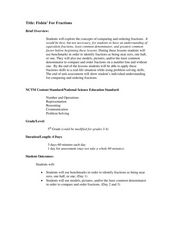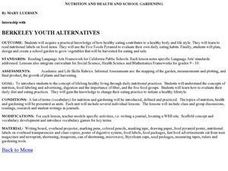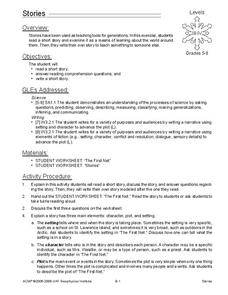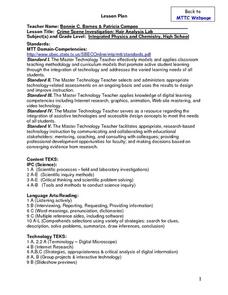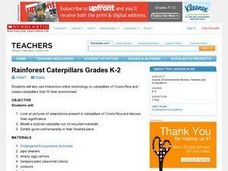Curated OER
Good News - We're on the Rise!
Students build and observe a simple aneroid barometer to discover changes in barometric pressure and weather forecasting. They graph changes in barometric pressure for two weeks and make weather predictions.
Curated OER
How Does Your Garden Grow?
Students construct and maintain a school garden. In this gardening instructional activity, students plan the construction of the garden by writing letters to local businesses asking for supplies and materials; students build the garden...
Curated OER
Fishin' For Fractions
Fifth graders compare fractions. In this fraction instructional activity, 5th graders identify whether a fraction is closest to zero, half, or one and use common denominators. They put fractions in order and complete real-life fraction...
Curated OER
Nutrition and Health and School Gardening
Students examine how healthy eating contributes to a healthy body and life style. They read nutritional labels on food items. They use the Five Foods Pyramid to evaluate their own eating habits. They plan, design, and create a school...
Curated OER
Money Makes the Fair-Go-Round
Students explore the value of money. For this money lesson, students investigating combining amounts of money and making change. Students count sets of money and make fair trades. Resources are provided.
Curated OER
Balancing Chemical Equations
Ninth graders explain how atoms and molecules form different substances during chemical reactions and how these processes require losing, gaining or sharing electrons. They correctly write chemical formulas and show how a balanced...
Curated OER
Making Blood!
students research blood's components, and use their math skills to recreate a model of whole blood using commonly found food items.
Curated OER
Lights On ! Lights Off! Exploring Human Settlement Patterns
Third graders write informational paragraphs based on the settlement patterns of the United States. In this settlement lesson plan, 3rd graders read about population and how it affects where people settle next.
Curated OER
Stories
Students read and write a short story. In this short story lesson plan, students read a short story and answer comprehension questions on it that teaches them about the world around them. Then they write a short story to teach...
UAF Geophysical Institute
System Interactions: The Lorax and the Truffula Tree
If the Lorax were to write a letter, what would he write? Introduce your class to systems and feedback loops through the whimsical stylings of Dr. Seuss. Learners take on the Lorax's point of view to write a letter, among other activities.
Constitutional Rights Foundation
Unauthorized Immigration and the US Economy
As part of a study of immigration and the U.S. economy, class members assume the role of newspaper editors to determine which submitted letters to print on their paper's editorial page to present a balanced view of the debate.
Curated OER
Crime Scene Investigation: Hair Analysis Lab
Students participate in a hair analysis lab. Using a digital microscope, students compare and contrast hair samples. They determine if the hair samples are human or animal. After completing lab results sheets, students share their...
Curated OER
Which Colored Filter Will Decode a Secret Message?
Students investigate how to create secrete messages through filters. They view pictures with red and green filters and discuss what they observe. They select the color filter that works best to read secret messages. They view pictures...
Curated OER
PLANETS IN PROPORTION
Students discover scales for both the solar bodies' relative sizes and their distances from the sun. They find equatorial circumference and volumes of their solar bodies. Students apply estimation strategies and proportioanl reasoning to...
Curated OER
A Crust Full of Rocks
In this rock worksheet, young scholars answer seven short answer questions about the composition of the earth's crust. Questions refer to metamorphic, igneous, and sedimentary rocks.
Curated OER
Clouds and the Weather
Fourth graders analyze the relationship of clouds and local weather. Students also observe and record cloud data and weather conditions daily as they research different cloud types. The data is analyzed looking for trends in daily...
Curated OER
Capturing the Moment in 3-D
Young scholars analyze the sculpture "Rearing Horse" by Adriaen de Vries. In this visual arts lesson, students examine the sculpture and then draw and sculpt animals from life, trying to capture a moment frozen in time.
Curated OER
Secrets from the Sea
Students utilize technology for research. They research the potential causes of the sinking of the Hunley.
Curated OER
Volume
Pupils participate in a teacher demonstration of the water level in different beakers to investigate the measurement of volume. Next, working in small groups, they replicate the demonstration and determine how the measurements in the...
Curated OER
Heat And Heat Transfer
Students role play molecules in a container as the container is heated to develop a definition of heat and temperature. They also observe demonstrations of conduction, convection, radiation, and phase transfer. Using these observations...
Curated OER
Pass the Plate
Young scholars define constructive forces. They describe how landforms are created as a result of constructive forces. Students recognize active volcano areas in the United States. They demonstrate an understanding of Panagea.
Curated OER
Rainforest Caterpillars Grades K-2
Learners are told that after they discuss and examine of rainforest caterpillars, they are going to create their own rainforest caterpillar based on the information they have studied. They are given the habitat scenarios on 3x5 cards.
Curated OER
Mohs Hardness Test
Fifth graders examine what the Mohs Hardness Scale is before testing a number of minerals to determine their place on the scale. They test a fingernail, a penny, a knife blade, a metal file, and several unknown minerals and rocks using...
Curated OER
Density
Second graders watch a demonstration and complete an experiment to determine how an objects' density allows it to float or sink. They work in small groups to assimilate the characteristics of items that float as opposed to simply...


